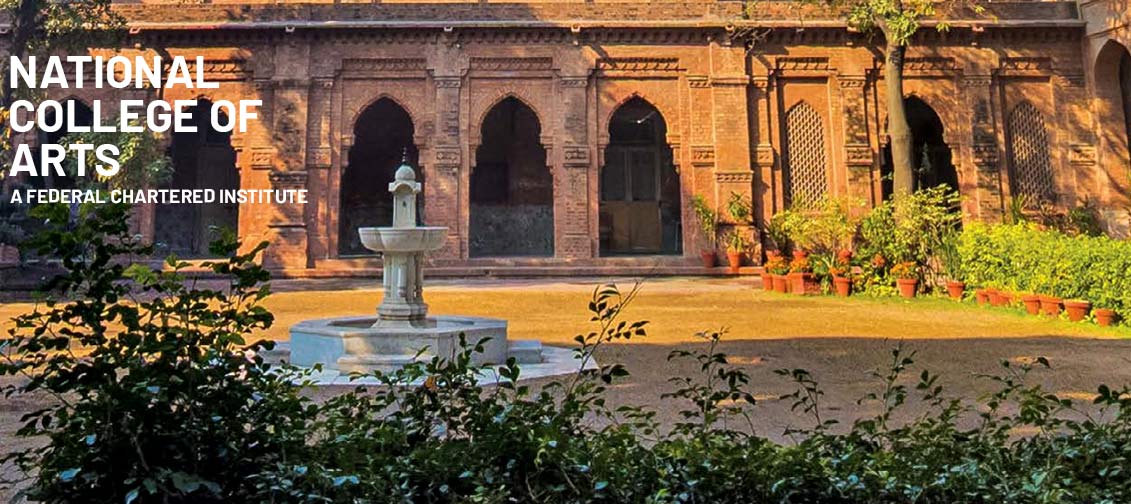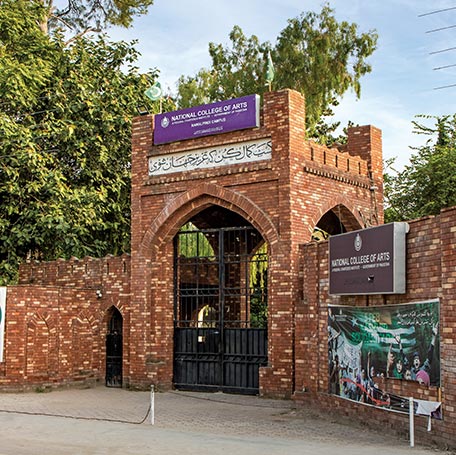
TO NCA
At the National College of Arts (NCA), we believe that education is a fluid process, where students are assisted in the exploration, investigation and expression of their ideas.
The NCA offers a number of professional undergraduate and graduate degree courses. Courses have been conceived in such a way in which the student’s unique creative and internal impetus is aligned with the requirements of the job market in an increasingly diverse world. Tradition and individual talent both form an integral part of learing for a more meaningful participation in the future of art education. Freedom, plurality and an interdisciplinary approach allow ideas, histories, theoretical positions and technical procedures to be located within a critical space. The diversity of both the faculty and the student body ensures that no particular ideological or theoretical position is sacrosanct. Discussion, critique and research form the backbone of all the courses offered. We are unique as we draw both our faculty and our student body from a diverse cultural mix. This facilitates and allows a pluralistic culture within the College. Students benefit from exposure to a wide range of ideas, sub-cultural identities and practice drawn from often conflicting and contested geographical, socio-political and historical locales.
The visual is a language that must be learnt. The knowledge of technique and medium forms the basis of personal expression, and that innovation comes through understanding and learning of visual language. We believe that creative expression has the power to change the world. An artist is a philosopher, linguist, idealist, writer, critic, theorist and above all human at the same time.
Our students have made their mark and moved on to become pioneering professionals in a number of creative fields both locally and internationally. Professor Mark Ritter Sponenburgh, the first Principal of NCA, introduced the modern art college curriculum, in 1958. The modern movement in Pakistani art had already begun with Professor Shakir Ali, teacher and Principal at the NCA. The students of Professor Mark Ritter Sponenburgh at the NCA, spearheaded modern art education in Pakistan.
The Renaissance man Bhai Ram Singh; alumnus, faculty and principal at the Mayo School, was an architect, designer, and craftsman who in one short, inimitable lifetime discovered in himself, both a builder and a wood carver. Aitchison College, the Lahore Museum and the NCA itself bear testimony to his greatness.
The history of the NCA is bound up with the incredible legacy of personalities that have emerged from it. Nayyar Ali Dada’s eclectic expression bears much of Pakistan’s creative expression in architecture; Professor Emeritus Khalid Iqbal gave us the sensitive soul of the Punjab in painting; Zahoor ul Akhlaq the reflective artist, left behind an imperishable legacy; Mian Ejaz ul Hassan the painter and Mian Salahuddin the ceramist paved the way for exploring new avenues in their respective disciplines. Nayyara Noor, whose music and voice has touched the hearts of generations; graphic designers Niaz Ali Shah and Ahmad Khan established the technical, perceptual, theoretical peripheries of publicity and graphic design and what is now called Visual Communication Design. Professors and artists the likes of Professors Salima Hashmi, Colin David, Saeed Akhtar and Muhammad Asif trained entire generations that studied at the NCA. Such has been the contribution of others, such as Professors Kamil Khan Mumtaz, Javed Najam, Tanveer Hussain, M.H Jafri, Abdul Rehman Khan, Sheherezade Alam and Bashir Ahmed who are all pioneers in their fields. The Textile Design Department was established under the leadership of Professor Abbasi Abidi, who later on became the Principal of the NCA. The product designer Professor Qadir Bakhsh, the founding father of the department of Product Design established a venerable reputation nationally and internationally; as did Ustad Mohamed Ali with his fine woodcarvings. Shirin Pasha, the film-maker with the sensibility of a painter founded the department of Film & TV and Professor Iqbal Hassan the eternal academic took charge of teaching Art History and headed the department that can rightly be called the intellectual backbone of studio programmes offered at the NCA.
The first Musicology and Film and Television degree programmes offered in Pakistan were initiated at the NCA in 2002 and 2004 respectively. Apart from the establishment of pioneering departments, the NCA, its faculty and students have been advocates and participants of pivotal heritage and conservation projects, such as the conservation of the Lahore Fort.
The NCA library and archives section house original documents spanning over a hundred years, as well as a continuously updated bank of contemporary publications; this makes the NCA library one of the best visual art research resources in South Asia. The environment at the NCA is professional, creative and research oriented, and has over the years, attracted a number of professionals and educationists of calibre from all over the world who have come to this institution for teaching and learning. All of our faculty members are practitioners in their fields.
Keeping up with our commitment to fostering innovation and growth, we are thrilled to announce the establishment of two new departments in the undergraduate stream: Fashion Design and Multimedia Art. These additions will offer state-ofthe-art education and training, equipping students with the skills and knowledge needed to thrive in the ever-changing landscape of the creative industries. Our Fashion Design department will focus on the latest trends, technologies, and sustainable practices in the fashion world, while the Multimedia department will delve into the realms of digital media, animation, and interactive game design.
Moreover, we are proud to expand our presence with the opening of a new campus in Gilgit Baltistan. This strategic expansion allows us to extend our unique educational experience to a broader audience, providing more aspiring artists and designers with the opportunity to benefit from our exceptional programs and resources. By bringing NCA’s rich tradition of excellence to Gilgit Baltistan, we aim to inspire and nurture the next generation of creative leaders in this culturally vibrant region.
We believe that the cutting edge of creativity and expression is to be discovered within ourselves and for that we individually nurture the potential in each student. We teach our students to reject nothing, to examine everything; they are taught how to think but never what to think. Expression is to be discovered within ourselves and for that we individually nurture the potential in each student.

HERITAGE
The Arts and Crafts Movement (1850-1920) emerged and gained strength in response to the rapid social and economic changes brought about by the Industiral Revolution. The movement advocated the promotion of indigenous arts and traditional craftsmanship. Many of the proponents of art and craft education were followers of the Arts and Crafts Movement and disciples of William Morris and his counterparts.
Sir JJ School of Arts, Bombay, Govt. College of Art, Madras, Govt. College of Art and Craft, Calcutta and the Mayo School of Arts, Lahore were the four art institutions established by the Crown in India. The Mayo School of Industrial Art was set up in memory of the assassinated British Viceroy of India, Lord Mayo. John Lockwood Kipling (father of author Rudyard Kipling), a teacher of painting, sculpture and architectural embellishment and proponent of the Arts and Crafts Movement working then at the J.J. School of Art Bombay, was appointed as the Mayo School of Arts’ first Principal. He also held charge as the curator of the Central Museum Lahore.
The Mayo School of Arts was established in 1875 on the lines of the Kensington model, in conjunction with the Central Museum. The School was to document the arts and crafts of the Punjab, with the aim of training excellent craftsmen who would serve the demands of craft production. The Mayo School became a center of craft excellence under the direction of a line of accomplished heads, including J.L Kipling, Sir Percy Brown, Lionel Heath, Bhai Ram Singh and S. N. Gupta. The school was also tasked with the monitoring of craft institutions of the Punjab and in such capacity, was well connected with other institutions throughout the province. Over the years, inclusion of the fine arts became part of the school’s curriculum, along with architectural drafting and drawing, embellishment crafts, woodwork, wood carving, weaving, embroidery, blacksmithy, metalwork and bookbinding.
Following the partition of the Indian Subcontinent, the Mayo School underwent many changes. From 1956 to 1958 the Mayo School went through a process of restructuring by the Government of Pakistan and became the National College of Arts. Professor Mark Ritter Sponenburg (1916-2012), a graduate of the prestigious Cranbrook Academy of Art, Michigan, and the L’ Ecole des Beaux Arts Paris, was given charge as Principal. A celebrated artist, well versed in American and European art and design education, Sponenburgh introduced the modernized curriculum which is the root of National College of Arts even today. He encouraged an understanding and exploration of indigenous craft and culture. The exhibition ‘Folk Arts of Swat’ based on research in Swat, in collaboration with NCA students, is still on display at the Lahore Museum.
The departments of Fine Arts, Design and Architecture were established in 1958 and the Mayo School was finally transferred to the Ministry of Education. The College was sanctioned a Board of Governors as recognition of its superior quality of education. The new breed of artists, designers and architects emerged as professionals who helped in establishing trends that would modernize the art scene and industry. A new policy introduced in 1972 recognized the achievements of the College and furthered its development as a center of excellence in the arts. A unique measure of autonomy, under the Federal Government, was ensured from this point on. In 1985 the College was granted a degree awarding status. This also empowered the NCA to institute graduate programmes in the field of Visual Arts and Interior Design (1999), Multimedia Arts (2001) and Communication and Cultural Studies (2005). The College offers MA degrees in Visual Art, Interior Design and Multimedia Design and an MPhil leading to PhD in Communication and Cultural Studies. The departments of Music, Film & Television were established a few years later, along with the Center for Conservation and Cultural Heritage Management. The Research and Publication Center was established in 1999, and has produced milestone publications on history, art, and the social sciences. A project for the restoration and conservation of the archival records of Mayo School of Arts was also initiated under this center. The NCA Archives is considered an essential resource for research on art history and the history of art, craft, design and architecture of Pakistan and pre-partition Punjab.
The National College of Arts successfully transitioned from an Annual System to Semester System in 2020 with all Degree Programme courses and structures approved from the Academic Committee of the Board of Governors NCA with promulgation of NCA Act 2021. NCA has achieved another milestone of being a Federal Chartered Institute which has elevated its status as a unique institution in the field of Art and Design. It is indeed a moment of pride for the National College of Arts that it has gained the status of a Chartered Institute. Since then NCA has continued to expand its outreach and infrastructure.
We hope that the coming years bring more seminal prospects to fruition taking NCA to new heights for the times to come.

The Mayo School of Arts was established in 1875, with the intention of having a centre that served the demands of the local and British peers and the government by preserving and patronizing the crafts of Punjab.
The foundation stone of the Kipling Block (now the Administration block) was laid on January 3,1880 by Prince Albert Victor and presents an early example of the utilization of Mughal imagery. Referred to as ‘late Mughal’ style in contemporary accounts, its construction was supervised by the famous engineer from Lahore, Khan Bahadur Ganga Ram, who later became well known for his philanthropy. Initially, the building consisted of six rooms.Temporary additions were made to it in 1881. In 1891 these temporary structures were made permanent in accordance with a design prepared by the then Principal. Now the school had proper workshops equipped with tools and machines. In 1902 four large machine workshops and photolithography studio were already functioning. The fountain in the front of the main entrance was designed by Sardar Bahadur Bhai Ram Singh, much admired as a designer and craftsman when selected to decorate a section of Queen Victoria’s Osborne House. Kipling utilized his crafts and sculpture background to construct a comparatively simple but elegantly detailed structure. The beautifully laid brick masonry of the walls ends at the roof with an outer cornice of red sand- stone which historian Latif mentions, had been obtained from Delhi.
NCA is ideally located in the heart of the cultural capital and enjoys a historically rich neighbourhood.The College is flanked on either side by the Lahore Museum and the Town Hall respectively, with the Punjab University Old Campus situated across the road. The lure of the city for students is not just limited to the magic of history and the world heritage sites. The area between the Badshahi Mosque and the NCA offers a wealth of ideas, possibilities for material exploration and inspiration. This is a city where people make things on site and a living is made from ideas; from metalwork and plastics to print workshops and digital art. This is an extraordinary space for research, collaboration and innovation, one that is utilized by NCA students as a home away from home from the first day of their entry into the College.
Not far away is Royal Park, the iconic cinema district where the Pakistani film industry lived and worked in an atmosphere of its own creation. Cinema hoardings with their unique style were painted and repainted in its narrow lanes.
Recently Lahore has begun to reclaim its place in South Asia as a cultural and intellectual hub. The city is host to theatre shows, art exhibitions, music festivals, symposia and lectures all year round, with local and international participation, all of which are accessible to the students of the NCA.
What is unique about studying at the NCA is that students are not merely observers in the drama of a city. Students of the NCA take their performances into the public sphere, in its streets, galleries and work in its industries.
The Rawalpindi campus was set up in the historic Liaquat Memorial Hall in January 2006. The iconic Liaquat Hall was designed by the Greek Architect, Doxiadis. This multilevel building lies in the heart of Rawalpindi city. It has a long, thriving history of performing arts. The Rawalpindi/Islamabad area has an active body of professionals, many of whom are NCA alumnus, as well as other Bodies which have been working towards the setting up of professional art schools. Their resources are utilized in addition to the inputs that the current NCA faculty provides.
The project is a turning point in the history of the NCA. Bearing in view the ethos and model of the NCA, an academic plan has been developed to ensure continuity in the integrated teaching of the visual arts through the combined foundation course.
To encourage cultural diversity and gender parity in the student body, the Rawalpindi Campus admits students countrywide, following the same procedure of testing and criterion of eligibility as already established at the NCA, Lahore.
The campus has a visiting faculty hostel, equipment for studios and laboratories, academic buildings and a library. The faculty, in keeping with the NCA model, comprises of a core permanent faculty, as well as visiting, guest and contractual faculty, both national and international.
It is the student body that truly makes the NCA distinctive. Our students come from all parts of the country and from extremely diverse socio-economic backgrounds. The variety of backgrounds, identities, ideological positions and languages become our strength.
The diversity of our student body engenders a unique NCA culture where debate and discourse are encouraged. This promotes creativity, understanding, individuality and tolerance. Our foreign students are easily absorbed into the College stream.The Ministry of Federal Education has allocated an auditorium space in Islamabad with the aim of making our local art and culture accessible to a larger audience. The initiative has proven especially beneficial in the exchange of art and ideas, bolstering the image of Pakistan internationally.
The National College of Arts holds art exhibitions, cultural symposia and conferences as well as NCA productions, documentaries and films at the auditorium.
A space in the capital city, dedicated to artistic endeavours has increased access for foreign missions to view art and engage in artistic activities.
The National College of Arts also offers short courses on various traditional and contemporary arts for the international missions in Islamabad and for the public at large.
These activities not only help advance our academic linkages internationally but draw artistic activity to Pakistan. The intention of the NCA is to foster the promotion of culture whilst embracing and innovating in order to remain at par with contemprary trends in the arts and design.
The establishment of the Gilgit Baltistan Campus constitutes a distinctive socio-historical juncture, which is based in a confluence of immensely rich cultures of art education, where a 150-year-old art institution with a thoroughly profound tradition of learning has established a center of education in a region with an equally exhaustive regional art history. Being the first in the region to adopt the Higher Education Commission (HEC’s) Associate Degree initiative, we have envisioned an innovatory academic and infrastructural framework based on a deep appreciation of the regional art and design academia at our Gilgit Baltistan Campus.
For the consistent running of intensive skill-based educational programs, state of the art computer labs, art galleries, student workshops equipped with especially provisioned toolkits and machinery, and well-lit and ventilated studios have been set up at the Gilgit Baltistan Campus. This Campus aims to offer a centralized facility for budding artists, art and design graduates, artisans, writers, researchers, and international artists to nurture a one-of-a-kind culture of learning and skills acquisition.
We have planned to cater amply to the collective needs of the learning community in a purpose-built campus. Additionally, a separate hostel facility for the students and visiting national and international artists has also been provided. At the Gilgit Baltistan Campus, while we aim to offer skill-based education to the regional youth foreseeing their current academic and employment needs, it is hoped that a sense of ownership within the zealous young minds for preserving and furthering the regional cultural heritage for progeny will be fostered. Conserving the regional folklore and craft, while making it accessible to foreign audiences through international artist residencies, a lasting impression will be marked for generations to come.
As it stands on the cusp of its 150th year, one of the oldest art institutions in South Asia, the National College of Arts has taken a critical step towards widening the scope of educational opportunities for Gilgit-Baltistan’s local community. It is with great hope for a fertile future that the National College of Arts foresees the regional artistic landscape transform significantly in the next decades.









